Choosing the correct dimmer switches for your home may seem like a simple task, but homeowners need to be aware that there are specific types of dimmers for different types of light bulbs. Knowing the difference between leading-edge and trailing-edge dimmers is essential for choosing the right product for the light fitting and bulbs that you have. This will also ensure that your lights work for as long as possible, the switches or fixtures don’t get damaged, and that energy consumption is kept as low as possible.
Read on for an overview of what to keep in mind when choosing the correct dimmer switch for your home.
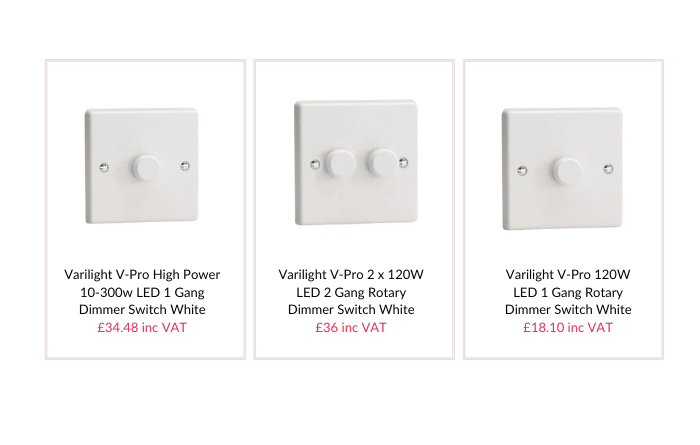
Varilight V-Pro 120W LED 1 Dimmer Switch
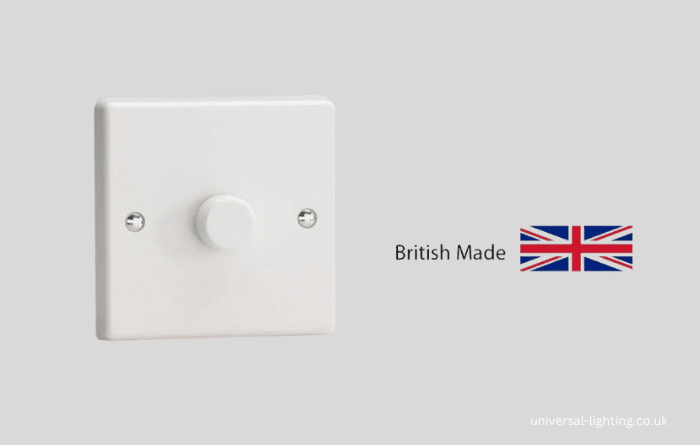
Varilight V-Pro 120W LED 1 Gang Rotary Dimmer Switch, £18.10
-
- Size: 85 x 85mm
-
- Colour: White
-
- Compatible with LED bulbs
This white dimmer switch integrates intelligent dimming technology, soft start, intelligent overload protection, and adjustable brightness settings. With three programmable modes, it adapts to suit most dimmable LEDs, specific leading edge type LEDs, and some external LED drivers.
The switch operates with a simple push for on/off and a rotation to adjust dimming. Designed for a maximum load of 120W for LEDs, the dimmer offers silent, smooth trailing edge dimming, and intelligent lamp-type detection for adaptive control.
Note that it’s not suitable for use with non-dimmable fluorescent bulbs and tubes, wire-wound or toroidal transformers, or electric motors. For other finishes such as polished chrome, satin chrome, antique brass, and bronze, please contact us directly.
Varilight V-Pro 2 x 120W LED 2 Dimmer Switch
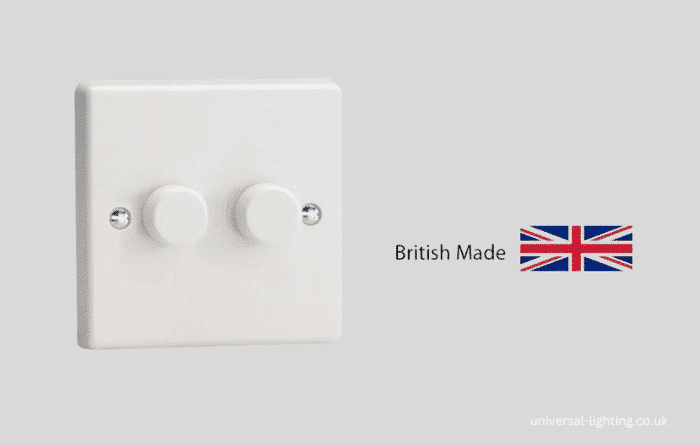
Varilight V-Pro 2 x 120W LED 2 Gang Rotary Dimmer Switch, £36
-
- Size: 85 x 85mm
-
- Colour: White
-
- Compatible with LED bulbs
This white dimmer switch features intelligent dimming technology, soft start, intelligent overload protection, and adjustable minimum brightness settings. It comes pre-set as a trailing edge dimmer with three programmable modes to cater to a range of LED requirements.
The operating modes are quickly and easily adjustable with the help of the user instructions. Functioning with a simple push for on/off and a rotation for dimming, this switch is also available in various finishes, including polished chrome, satin chrome, antique brass, and bronze.
Designed for a maximum LED load of 2 x 120W, it offers silent and smooth trailing edge dimming along with intelligent lamp type detection for optimal load control. Note: it’s not suitable for non-dimmable fluorescent bulbs and tubes, wire-wound or toroidal transformers, or electric motors. For other finishes, feel free to contact us.
Varilight V-Pro High Power LED 1 Dimmer Switch
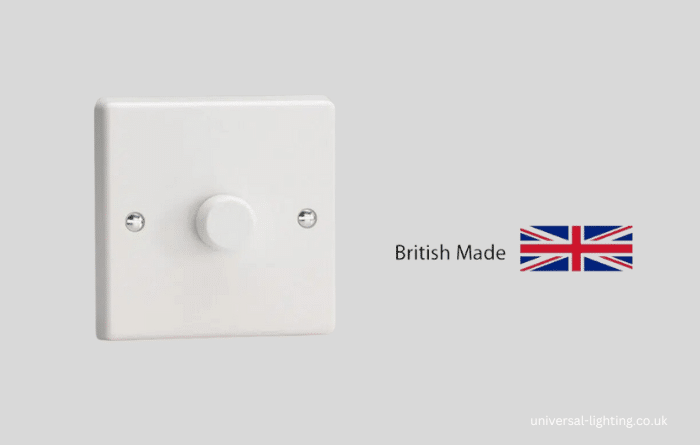
Varilight V-Pro High Power 10-300w LED 1 Gang Dimmer Switch White, £34
-
- Size: 85 x 85mm
-
- Colour: White
-
- Compatible with LED bulbs
This white dimmer switch is equipped with intelligent dimming technology, a soft start, intelligent overload protection, and an adjustable minimum brightness setting. It also comes with a 10-year manufacturer’s warranty. Set as a trailing edge dimmer by default, it offers three programmable modes suitable for various LED applications.
The switch employs an easy-to-use push for on/off and rotates to dim mechanism. It comes in various finishes, including polished chrome, satin chrome, antique brass, and bronze, among others. Engineered for a maximum LED load of 300W, this switch provides a smooth, silent trailing edge dimming experience, combined with intelligent lamp-type detection for adaptable load control.
Note: It is not suitable for non-dimmable fluorescent bulbs and tubes, wire-wound or toroidal transformers, or electric motors. For inquiries about other finishes, please contact us.
How Do Dimmer Switches Work?
Dimmers work by simply reducing the voltage supplied to the lamp, which in turn reduces the light output from the light bulb. There are many types of light bulbs and capsule lamps that can be dimmed but the requirements for each type can vary. If you select the wrong type of dimmer it may not work, could lead to reduced lamp life or even blow the dimmer or light fitting in extreme circumstances.
Benefits Of Using Dimmer Switches In Your Home
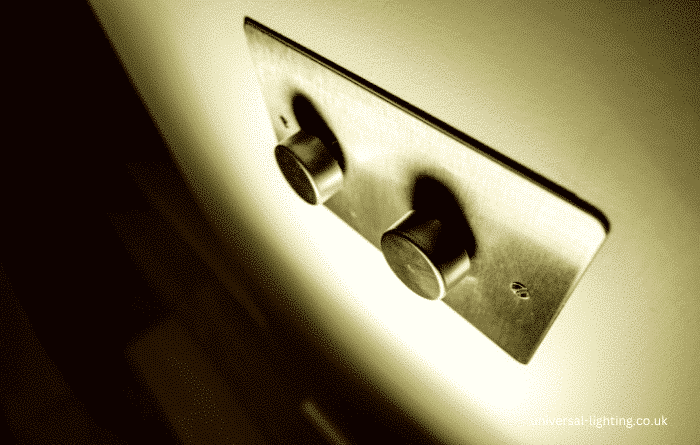
-
- Flexible Lighting Control: You have the convenience of adjusting the light intensity to match your mood or specific tasks, enhancing your home’s comfort and functionality.
-
- Energy Efficiency: Dimmer switches help reduce energy consumption by allowing you to use only the amount of light you need, contributing to a greener environment and lower utility bills.
-
- Extended Lamp Lifespan: The use of dimmers for your lighting can prolong the life of your lamps, requiring less frequent replacement and thus reducing your maintenance costs.
-
- Cost Savings: By curbing energy use and reducing the frequency of lamp replacement, dimmer switches can lead to substantial savings, making them a financially smart choice for your home.
-
- Improved Atmosphere: The ability to adjust lighting levels allows you to effortlessly create the perfect ambience for any occasion, from a lively dinner party to a peaceful evening reading session.
-
- Reduced Eye Strain: By enabling you to tailor the light level, dimming lights can help minimise eye fatigue, especially during prolonged periods of close-up tasks such as reading or crafting.
Types of Dimmers
Resistive Dimmers (Leading Edge)
-
- Compatibility: Works with resistive or inductive loads by reducing the load by shortening the A/C cycle at the input waveform’s leading edge.
-
- Intelligent Features: Best models feature soft-start and overload protection, which prolongs the lifespan of both lamps and the dimmer switch. These ‘intelligent dimmers’ can protect themselves from failure by turning down or off the lights when too many lights or transformers are mistakenly connected.
-
- Common Uses For Leading Edge Dimmers: Most often used to dim incandescent and mains voltage halogen light bulbs and capsules. Also suitable for dimming most electronic low voltage transformers, including wire-wound or toroidal transformers, and under certain circumstances, constant current dimmable LED drivers.
Leading edge dimmers are compatible with resistive or inductive loads and are able to reduce the load by shortening the A/C cycle at the leading edge of the input waveform, hence the term ‘Leading Edge’. The best of these are marketed as ‘intelligent dimmers’ and feature soft-start and overload protection to improve the life span of both the lamps and the dimmer. If you mistakenly connect too many lights or transformers to an intelligent dimmer it will protect itself from failure by turning the lights down or off until the load is corrected.
Leading edge dimmers are the most commonly used to dim incandescent and mains voltage halogen light bulbs and capsules. They are also used to dim most electronic low voltage transformers, including wire-wound or toroidal transformers and can also be used to dim constant current dimmable LED drivers under certain circumstances that will be explained later.
All dimmers are rated by wattage and leading edge dimmers are no exception. They are commonly available in 250w, 400w, 600w and 1000w modules. It is important to note that they also have a minimum load requirement of 25w, 40w, 100w and 150w respectively.
These wattages must always be adhered to and in the case of halogen lamps and capsules must be over-rated by at least 25%. GU10, G9 and GZ10 halogen lamps and capsules tend to arc in the latter part of their life. This is not dangerous in any way and is a characteristic of halogen lamps. This arcing creates an additional load on the dimmer and can overload the module resulting in excess heat and premature failure. The first indication of this happening is an increase in noise, often heard as a buzz from the dimmer switch.
It is important to note that all quality branded halogen capsules incorporate a fused link to protect the circuit in case of a short within the lamp. Non-branded cheap generic halogen lamps do not have this function and should be avoided. Never use a dimmer module that is not rated higher than the total load applied to it.
Resistive Dimmers (Trailing Edge)
-
- Compatibility: Works with resistive or capacitive loads by reducing the load by shortening the A/C cycle at the input waveform’s trailing edge.
-
- Intelligent Features: Best models feature soft-start and overload protection, which helps improve the lifespan of both lamps and the dimmer switch. These ‘intelligent dimmers’ can protect themselves from failure by turning down or off the lights when too many lights or transformers are mistakenly connected.
-
- Common Uses For Trailing Edge Dimmers: They are often used to dim electronic low voltage transformers (ELV) with capacitive loads on the primary circuit. Additionally, trailing edge dimmers can effectively dim incandescent, halogen, and LED lamps
Trailing edge dimmers are compatible with resistive or capacitive loads and are able reduce the load by shortening the A/C cycle at the trailing edge of the input waveform, hence the term ‘Trailing Edge’. The best of these are marketed as ‘intelligent dimmers’ and feature soft-start and overload protection to improve the life span of both the lamps and the dimmer. If you mistakenly connect too many lights or transformers to an an intelligent dimmer it will protect itself from failure by turning the lights down or off until the load is corrected.
Trailing edge dimmers are far more complicated than their leading edge counterpart and are more expensive to produce and purchase. They incorporate many features such as soft start; smooth control, silent running and multi-way dimming that greatly enhance the life of the lamps and fittings.
They are commonly used to dim most electronic low voltage transformers (ELV) with capacitive loads on the primary circuit. Trailing edge dimmers can also be used to dim incandescent, halogen and LED lamps effectively. They should not be used on older type of magnetic core and coil wire-wound or toroidal transformers.
Although a trailing edge dimmer is considerably more expensive to buy, it has many desirable attributes over its leading edge counterpart and in certain situations may be more appropriate.
Inductive Dimmer Switches
Inductive dimmer switches are specifically engineered for use on the secondary side of low-voltage or LED lighting systems. Unlike the typical wattage rating system used for resistive dimmer switches, inductive dimmers are rated in Volt-Amps (VA), a measure that accommodates both the voltage and the current in the circuit. This VA rating is vital as it demonstrates the dimmer’s ability to handle the power surge from the transformers, a characteristic that makes inductive dimmers unique.
These dimmers are designed to endure the rush of a current that transformers typically produce during operation, providing a stable and reliable dimming solution. To accomplish this, inductive dimmers are already over-rated, meaning they have a higher VA rating than the wattage of the connected load. This over-rating allows them to cope with the inrush current without compromising the performance or lifespan of the lighting scheme.
Despite their advantages, it’s relatively uncommon to find inductive dimmer switches in regular domestic settings.
Using Dimmer Switches With Fluorescent Fittings
Dimming fluorescent fittings is complex and can involve analogue or digital dimmers and a variety of different wiring schemes. These are expensive to install and are mainly used for commercial applications and are beyond the scope of this article.
That said, some domestic fluorescent fittings are becoming available that are dimmable. These are dimmed using an analogue-type dimmer. The fitting incorporates variable voltage high-frequency control gear or regulated ballast that is typically rated at 1 – 10v. These can be dimmed between 3% and 100% illumination by using a suitably rated dimmer but must incorporate a separate on/off switch.
With the phasing out of incandescent lamps, more and more fluorescent lamp manufacturers are making dimmable lamps available. They are at an advanced stage of development and although expensive at this time, it is anticipated that the price will reduce as they become more popular.
Dimming LED Lamps
-
- Mains voltage dimmable LED light bulbs can be controlled with standard resistive dimmer switches
-
- Non-dimmable LED lamps and light fittings cannot be used with dimmer switches
It’s important to note that non-dimmable LED lamps and light fittings cannot be dimmed. Any attempt to use dimmer switches with these non-dimmable LEDs could result in damage to the dimmer, lamps, or both.
On the other hand, mains voltage dimmable LED light bulbs and LED light fittings can be comfortably controlled using standard resistive dimmer switches. LED lamps are particularly appealing due to their low energy consumption and high energy efficiency.
However, these attributes can pose a challenge when selecting the correct dimmer switches. For instance, if you are trying to dim a small number of LED lamps, the total wattage might not be sufficient to load the dimmer.
As an example, four 5w LED lamps in a compact room will only total 20w, while a 250w dimmer switch requires a minimum load of 25w. In this case, the dimmer switch simply won’t operate. Therefore, a low-load dimmer switch rated at 5 – 50w would be more suitable in such circumstances.
Under normal circumstances, provided the minimum load is surpassed, dimming mains voltage LED lamps using dimmer switches isn’t an issue. For example, this British made Varilight V-Pro programmable dimmer is our default choice when dimming LED’s.
Dimming low voltage LED lamps is easily accomplished with dimmer switches by either adjusting the driver on the primary (mains) side or on the secondary (low voltage) side. Of the two, primary side dimming is preferable and easier to achieve. However, it’s essential that the LED driver is of a constant current type and dimmable.
Conclusion
When choosing a transformer or low-voltage light fitting, selecting the appropriate dimmer switches is crucial. While dimming most domestic light fittings can be fairly straightforward, you must make sure you’re choosing the right dimming module for the job – either leading edge or trailing edge. It can be challenging to determine this information when purchasing dimmers from general high street retailers, as it’s often not clearly stated, so to ensure you’re getting the correct fittings, we recommended consulting with or making your purchase from a specialist in lighting or electrical products.
Due to the large variety and different applications of dimmer switches, we do not offer them for sale online. This ensures that you do not accidentally select the wrong dimmer for your application as this can cause expensive and irreversible damage to transformers or the dimmer itself.
Should you wish to purchase a dimmer together with your light fitting we are more than happy to advise you and we supply all available types of dimmers in every finish available to match your existing switches and sockets.
Please use the contact us tab at the top of this page or telephone 0151-650-2138 for further information on selecting the right dimmer.
